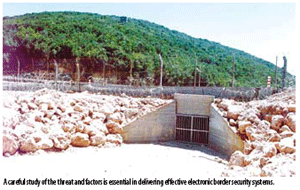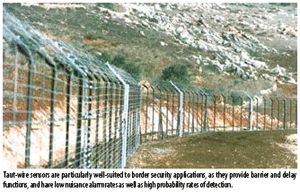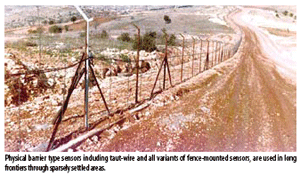The need to secure national borders is focusing attention on outdoor electronic technologies. This article examines what can be considered the ultimate perimeter security systema national border. It also looks at the newest technologies used in wide-area border surveillance.
The need to secure national borders is focusing attention on outdoor electronic technologies. This article examines what can be considered the ultimate perimeter security systema national border. It also looks at the newest technologies used in wide-area border surveillance.

Every border is different and, indeed, sections of larger borders pose wildly different problems to security system designers. A careful study of the threat and factors terrain, climate, national culture, accessibility and othersis required to develop an optimum working operational concept with the electronic systems to support it. Multisensor solutions protect all but the smallest of sites. Given the length and complexity of many national borders, varying threat scenarios and environments found along them, an open-design philosophy created by experienced designers with an array of sensor technologies is essential in delivering effective electronic border security systems.

In designing security systems, it is important to first consider the human factor. Most borders are low-threat environments, meaning day-to-day threat levels are much lower than soldiers would face in Basra or Kandahar. The paradox is that securing a border electronically actually requires more sophisticated technologies than many combat scenarios, because tolerance for false or nuisance alarms and available response resources per protected kilometer are typically much lower.
Relative importance of several key system design factors also varies along a border. Consider population density changes. The criticality of real-time assessment, rapid response and delay diminishes in sparsely populated remote border areas, whereas vandalism becomes more of an issue because it is less likely to be deterred and more expensive to repair. Urban areas, on the other hand, require physical barriers to deter and delay intruders as there is not much time to intercept them before they vanish into the general population. Rural areas may have less of a need for delay, but frequency of agricultural or recreational activity may mean that more extensive surveillance systems are required to assess activity detected by deployed sensor technologies. In Israel, people actually live on borders and there are countries where there is a no-man zone for several kilometers dividing two countries.
When the threat level is high, physical barrier type sensors including taut-wire and all variants of fence-mounted sensors, are used in long frontiers through sparsely settled areas; they become an essential element in urban and more populated areas.
Taut-wire sensors are particularly well-suited to such applications as they provide barrier and delay functions, and are renowned for exceptionally low nuisance alarm rates as well as high probability of detection. Furthermore, taut wire requires minimum power consumptiongood for use in large countries with limited or no border infrastructure. 
New Technical for Border Surveillance
For more remote border areas or areas where the threat is not considered extreme, some security analysts have concluded that area surveillance systems comprised of thermal imaging sensors and cameras using intelligent video analytics (IVA) and ground radar offer the best solution. While effective in many applications, these line-of-site technologies become increasingly ineffective in even moderately uneven and/or forested terrain. Unlike the taut wire presented above, they require constant power supply.
Most seasoned outdoor security practitioners feel that terrainfollowing sensors should be deployed forward of these wide-area surveillance systems to act as a trip wire to mitigate vulnerabilities. This combination provides in depth defense. If ranging sensors are used for the trip wire, it provides a particularly powerful example of the new paradigm of precisely locating and tracking intruders. Fusion of intruder or target data from the terrain-following line sensor and area coverage assessment sensor in a C41 system, for example, provide the most effective integrated system for border applications.
Two relatively new sensor technologies are currently being considered for use as the trip wire to cue wide-area border surveillance assets. Ranging guided radar and ranging fiber-optic sensors are buriedthis makes them resistant to vandalismand covert- -they are difficult to defeat. These attributes are particularly useful in remote areas where vandalism is unlikely to be deterred and where intruders have unlimited time to defeat more overt sensors. Both sensor types are currently offered by more than one vendor, and others will undoubtedly enter the market should this application of border security be widely adopted.

Seismic sensors, which include buried fiber-optic sensors, measure pressure waves in the earth caused by intruders; they were one of the first technologies used in outdoor security more than 40 years ago. However, inconsistent performance resulted in a plethora of other perimeter sensor technologies being developed. The main challenge for seismic sensors is that speed and propagation of pressure waves in the ground vary greatly as burial media density changes along a border, from rock to sand to soil, as well as over time from wet to dry, and from unfrozen to frozen.
The performance-defining problem becomes how to endure environmental variability while detecting threats using stealthy intrusion methods, and not detecting natural or man-made events or activity that are potentially in close proximity to the sensor, but not a security threat. While quantum advances in signal processing and computing power in the last 40 years have made seismic sensors perform much better, the fact remains that they form a very small part of today's traditional perimeter security market. They are, however, prevalent in a new market of protecting buried pipelines and detecting tunnelinga much different task than detecting footsteps in the sand.

Advantages
Most experts do not consider currently available COTS ranging fiber-optic seismic sensors buried in native soil to be capable of reliably detecting footsteps with a reasonable nuisance alarm rate. Nevertheless, there continues to be much interest in these systems as they can protect tens of kilometers without powera significant infrastructure savings in any border application. However, for such systems to be practical for long border applications, ability to distinguish human footsteps in a wide range of soil conditions and discriminate between multiple simultaneous targets must improve markedly. Also, in such lengthy applications as borders, one must consider the vulnerability of an architecture where single points of failure can affect very long distances. Advanced buried ranging fiber optic sensors may well be the trip wire of future border security systems, but they have not yet earned a reputation based on performance in the real world.
Buried guided radar sensors, also called ported or leaky coax, are true volumetric sensors that have protected high-value perimeters around the world for more than 30 years. They operate by detection motion in a defined volume surrounding the sensor cable. The first buried guided radar sensor was a ranging system, but cost of providing ranging with 1970s technology resulted in it being replaced in the perimeter market by more cost-effective non-ranging zoned systems. However, modern digital signal processors and radar techniques have now made ranging guided radar systems more cost-effective than zoned sensors. The ranging feature has also reduced cost per kilometer and made the technology far more adaptable to varying soil conditions.
Buried guided radar sensors are covert and terrain-following; they provide a very high probability of detection and are highly resistant to nuisance alarms from small animals and vegetation. The ability of the latest variants to precisely locate intrusions to within a few meters make ranging guided radars a force multiplier that can reliably detect border intrusions, handing them off to wide-area surveillance systems that assess the threat and track validated intruders until they can be interdicted.
The trip-wire sensors and wide-area surveillance technologies described are geospatially aware and are best complemented by GIS/GPS-based command-control systems that track coordinates of potential targets and response forces. This enables border patrol commanders to prioritize threats and make the best possible use of scarce resources.
Need to secure national borders is focusing attention on outdoor electronic security technologiespreviously a specialized niche in the broader security market. Many of today's perimeter technologies are adaptable to this new requirement. A good example is combination of physical line sensorslike taut wirewith a covert buried cable volumetric sensor, combined with CCTV and/or radar (when infrastructure is available). Both basic sensor products offer high probability of detection and low nuisance alarm rates with minimal infrastructure; they are, therefore, suitable as a launching pad for many typical border applications.
In the future, many of today's technologies may be superseded by newer technologies driven by investments in homeland security. There will be no single solution for all borders or even along a single border. Mistakes will be made along the way, but in the end, optimum systems will result from deployment of combinations of proven technology with incremental adoption of new technologies as they are developed and proven in the real world.